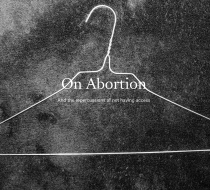On Abortion Favorite
On Abortion documents and conceptualises the dangers and damages caused by women’s lack of legal, safe and free access to abortion
Under “natural” circumstances, the average woman would fall pregnant about 15 times in her life, resulting in ten births. Seven of those infants would survive childhood. For centuries, people have searched for ways to delay or terminate pregnancy. Today, safe and efficient means of abortion finally exist, yet women around the world continue to use ancient, illegal or risky home methods. Every year, 47,000 women around the world die due to botched abortions.
Why do they take the risk?
Across countries and religions, millions of women are blocked from abortion technologies by law and social coercion, and are forced to carry pregnancies to term against their will. Some are minors and rape victims. For many, the pregnancy is not viable or poses health risks. Women are often criminalised and persecuted in countries where abortions are considered illegal. Furthermore, in El Salvador, women suffering a miscarriage are being charged with homicide, facing prison sentences of up to 40 years.
Regrettably, while violating patient confidentiality —even when termination of pregnancy is medically necessary to save the patient’s life; healthcare providers have been known to denounce those who have attempted self-induced abortions. On the other hand, anyone who assists a woman abort in a country where it is illegal can be incarcerated and may even risk their lives to perform the procedure.
In 2016, for the first time in history, Pope Francis allowed Catholic women who had carried out abortions to seek forgiveness through confession. But while this may seem like a step forward, it perpetuated the stigma of guilt that surrounds women’s choices. In the meantime, politicians exploit abortion as campaign currency; making reproductive issues a political matter, rather than a question of rights.
Laia Abril’s long-term project A History of Misogyny is visual research undertaken through historical and contemporary comparisons. In her first chapter On Abortion (2016) Abril documents and conceptualises the dangers and damages caused by women’s lack of legal, safe and free access to abortion. Continuing with her painstaking research methodology, she draws on the past to highlight the long, continuous erosion of women’s reproductive rights through to the present-day. Her collection of visual, audio and textual evidence weaves a net of questions about ethics and morality, and reveals a staggering series of social triggers, stigmas, and taboos around abortion that have long remained invisible.








